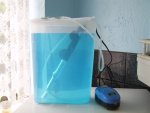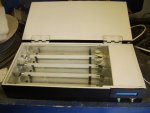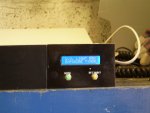Andrew Cowan
Senior Member
Develop
The brown stuff is ferric chloride. Long shelf life, works when cold, very messy. Lots of us on here use 'clear stuff' (something theosulphate?), which needs to be hot, but is faster and cleaner.
Resist strip
Bit of developer in a tray. Cheap and simple and fast. Get it from rapid cheaply.
Bubble etch (heated)
Option 1 - tray. Cold, little agitation. Slow, cheap.
Option 2 - homemade tank. Fishtank heater, aquarium pump for bubbles. Fast, cheapish, good results.
Option 3 - very expensive bubble etch tank. Fast.
Tin wash
Coats the boards in tin. We've never done it at school, makes it more resistant to corrosion. I wouldn't bother.
Hope this helps!
Maybe £15 for all chemicals?
The brown stuff is ferric chloride. Long shelf life, works when cold, very messy. Lots of us on here use 'clear stuff' (something theosulphate?), which needs to be hot, but is faster and cleaner.
Resist strip
Bit of developer in a tray. Cheap and simple and fast. Get it from rapid cheaply.
Bubble etch (heated)
Option 1 - tray. Cold, little agitation. Slow, cheap.
Option 2 - homemade tank. Fishtank heater, aquarium pump for bubbles. Fast, cheapish, good results.
Option 3 - very expensive bubble etch tank. Fast.
Tin wash
Coats the boards in tin. We've never done it at school, makes it more resistant to corrosion. I wouldn't bother.
Hope this helps!
Maybe £15 for all chemicals?






